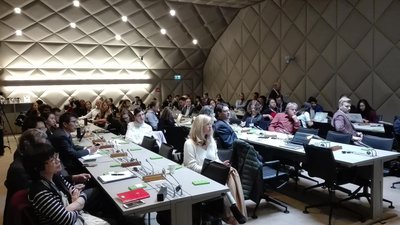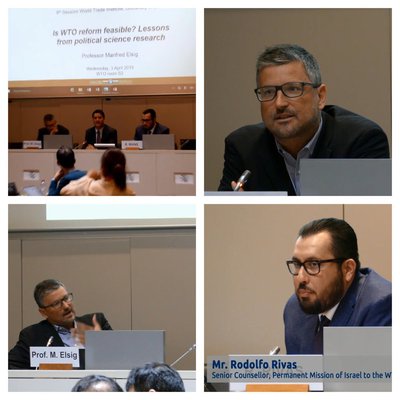5 Apr 2019
Is WTO reform feasible? Lessons from political science research
A summary by Anvar Rahmetov of Prof. Manfred Elsig's speech at the 3 April Trade Lecture Sessions @ the WTO, organized by the Embassy of Israel in Switzerland.
The audio of this event is available below. A video of the event is available via the Embassy of Israel in Switzerland's Facebook page.
Professor Elsig brought in insights from political science and international relations research to assess if the much-discussed WTO reform would be feasible politically. While legal scholars have recently discussed, in great detail, where the problematic areas of the current system are, and ways of reforming them, political scientists offer unique insights into the political feasibility of such reform proposals.
In discussing the WTO context, Professor Elsig reminded, it is important to look at wider research into international organizations, as well as into the history of the precursor of the WTO, the GATT, and to synthesize the critical conditions that made those reforms possible. The next question is whether similar conditions are present in our days.
The toolkit
Professor Elsig then presented the three “grand” schools of thought in international relations: realism, liberalism and social constructivism, as well as the insights into the WTO developments offered by each school.
Realism puts power and power relations at the center of its analytical narratives. According to Gruber (2000), big trading nations have “go-it-alone” power, and the history of the GATT/WTO knows many instances when a handful of key players agreed on critical issues and presented their consensus to the rest of the membership to take up, unaltered. In fact, the evolution of the GATT into the WTO in one realist narrative was the powerful nations signaling the expansion of the GATT system, with the opting out nations risking to lose their business attractiveness.
Liberalism emphasizes that common interests, rather than power, move international processes, including trade negotiations. For liberals, the history of the GATT/WTO consists of successive rounds of mutually beneficial tariff negotiations and other mutual market concessions. Representatives of this school, e.g. Copelovitch and Putnam (2014) focus on the context in which international organization reforms take place, showing how existing agreements and experience with past reforms shape time-limitations, exit clauses and dispute settlement provisions in new agreements.
Finally, social constructivism stresses the importance of (shared) norms of individuals and governments, as well as the consensus on the best way to proceed. For social constructivists, like, for example, Ikenberry (2001), reforms in international organizations happen during “constitutional moments” such as the end of the Cold War for the WTO or the end of the World War II for the Bretton Woods institutions, and the past successes of these institutions is explained by absolute domination of liberal norms in politics and the economy. They key question for social constructivists is how norms emerge and spread, as exemplified by Finnemore and Sikkink’s (1998) research into reciprocal concessions and gradual liberalization.
Which reforms: definitions and cases
When referring to reforms, scholars of and practitioners at the WTO refer to a multitude of changes, varying in type (market access commitments vs. institutional design), functional areas (decision making, dispute settlement, regime management), speed (grand vs. incremental) and formalization (formal vs. informal). Much of the GATT developments, for example, were driven by informal country groupings (Group of Eighteen, Green Room etc). The role of the WTO Secretariat in negotiating rounds has seen constant reductions, from chairing negotiation groups to merely providing consulting and administrative services, in a gradual and an informal way (Elsig 2010).
One puzzling case of reform is the emergence of the Dispute Settlement Understanding (Elsig and Eckhardt 2015; Elsig 2017), with right to a panel, automatic adoption of panel findings, the founding of the Appellate Body and strengthened implementation mechanisms. It is a case of a grand reform in institutional design, where parties negotiating were surprised by the result of negotiations – a highly legalized dispute settlement system. The three schools of thought each offer different explanation of why it happened. The realist school maintains that the rules negotiated during the Uruguay Round reflected interests of the United States, so the US gave it full support. The liberal argument is that the US Trade Representative used the DSU to “tie Congress’ hands” when it came to trade conflicts.
Professor Elsig, borrowing from liberalism and social constructivism, and based on interviews with stakeholders, discovered that the emergence of the DSU was a result of the interaction between a particular negotiating environment and an “experiential learning” of the European Communities that resulted in the convergence of the European and the US views on the DSU.
The DSU negotiating environment was characterized by cooperative bargaining in a value-creating environment because the public spotlight and political conflict rested in other areas of international trade. The negotiators had, as a result, certain autonomy and discretion from their capitals, which created a necessary environment to build trust and move forward on negotiations. The EC experiential learning occurred as the Communities improved their record in winning the GATT cases over time, and strengthened its legal teams both in dispute settlement and discipline negotiation. Other important, but less salient factors were the “constitutional moment” - the end of the Cold War and fall of communism, and the single package approach with cross-concessions facilitating the overall institutional reform.
The context today
The context of trade policymaking changed a lot since the DSU days. Firstly, the imbalance between the rule-making and the dispute settlement functions of the WTO grew dangerously large. As early as 2000, Goldstein and Martin warned that the increasing legalization of the WTO dispute settlement would impair negotiations on new disciplines, as increased membership grows increasingly careful about commitments which are strictly enforced, and as more and more domestic constituencies learn about the WTO and block value-creating proposals which harm them.
Second, there is “eye of the beholder” problem – members support or oppose the DSU based on their track record in dispute cases. With the largest economy in the world losing many cases, it is no surprise that the WTO faces increasing politicization and criticism from that economy.
Third, the Single Undertaking ended being one of the three pillars of the WTO, making package deals spanning many policy areas increasingly difficult. The three salient features of the WTO – Single Undertaking, member-driven negotiations and consensus decision-making locked up in an “incompatible triangle of decision-making” with maximum two attainable at any given time. With the latter two still strongly present in the WTO, the Single Undertaking has evolved into the plurilateral approach, with grand reforms less and less likely.
Fourth, the issue areas in trade negotiations also changed. While earlier rounds were about “negative integration,” i.e. elimination of such trade barriers as tariffs, the salient issues of today are “positive integration” issues, where it is important to find common rules applicable to a large membership. This is evident from both the record of the WTO negotiations and the content of the Preferential and Bilateral Trade Agreements that proliferated as multilateral trade negotiations slowed down. Negotiating negative integration is easy, as the issues are limited and reciprocity is straightforward. This is not the case with positive integration.
Fifth, the G2 world of the 1980s evolved into the multipolar trade world, with China emerging as a heavyweight international actor.
Finally, the liberal normative consensus seems to have been eroded. Following the political pronouncements of the current US administration and the UK Brexiteers it is evident that the liberal norms are being increasingly challenged by economic nationalism. It would be wrong to assume, however, that economic nationalism has never resurfaced since the post-war years. One example from more recent past is the Reagan administration’s unilateral actions limiting international trade (voluntary export restraints, the Omnibus Foreign Trade and Competitiveness Act of 1988, etc.).
Which reforms are feasible: three scenarios
Having introduced the political science toolkit and the issues surrounding the WTO reform, Professor Elsig outlined three broad scenarios of the form the reforms could take. In the realist scenario, the United States will seek to rebalance the WTO to better reflects its current perceived interests. If that does not happen it will decide not to end the current DS deadlock, preferring instead a pre-WTO dispute resolution system. The key question under this scenario is what China would do: accommodate the US requests or act to counterbalance them.
In the liberal scenario, based on a widely-cited 1985 piece by Duncan Snidal, even with the hegemonic United States departing from the current multilateral trade system, the remaining members for whom reciprocity and joint benefits of the system are valuable would remain. Empirical signs in this direction are plenty, with key players except the US seemingly committed to continue using the current system, albeit with reforms and improvements.
In the social constructivist scenario, a new Geneva-based consensus has to emerge among the “epistemic communities” of the international trade (delegates, academics, issue experts). These new norms would reflect new realities and, if converged on by the critical mass of decision-makers, result in reform breakthrough.
Current developments point to the realist and liberal scenarios being most probable, with realist scenario highly contingent on the result of the 2020 elections in the United States.
Professor Elsig concluded on the positive note. Given the high politicization of reforms and their dominating the spotlight, there is a window of opportunity for breakthroughs in previously sensitive issues, like e-commerce or environmental goods.
During the discussion following the talk, participants exchanged views on the role, if any, that delegates in Geneva, the WTO Secretariat and bi-annual Ministerials could play in the reform process, on the role of the social media in politicizing the WTO and facilitating the spread of misinformation on trade issues, on the importance of informing domestic audiences about costs and benefits of trade-related economic adjustments, the various definitions of “fairness” in international trade, and the consensus inside the WTO.
References to the literature cited during the talk:
Gruber, Lloyd. Ruling the world: Power politics and the rise of supranational institutions. Princeton University Press, 2000.
Copelovitch, Mark S., and Tonya L. Putnam. "Design in context: existing international agreements and new cooperation." International Organization 68.2 (2014): 471-493.
Ikenberry, G. "John. 2001." After victory: Institutions, strategic restraint, and the rebuilding of order after major wars (2001): 353-67. Finnemore, Martha, and Kathryn Sikkink. "International norm dynamics and political change." International organization52.4 (1998): 887-917.
Elsig, Manfred. "The World Trade Organization at work: Performance in a member-driven milieu." The Review of International Organizations 5.3 (2010): 345-363.
Elsig, Manfred, and Jappe Eckhardt. "The creation of the multilateral trade court: Design and experiential learning." World Trade Review 14.S1 (2015): S13-S32.
Elsig, Manfred. Revival: The EU's Common Commercial Policy (2002): Institutions, Interests and Ideas. Routledge, 2017.
Goldstein, Judith, and Lisa L. Martin. "Legalization, trade liberalization, and domestic politics: a cautionary note." International organization 54.3 (2000): 603-632.
Snidal, Duncan. "The limits of hegemonic stability theory." International organization 39.4 (1985): 579-614.
Further info
Audio of event



